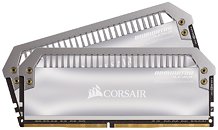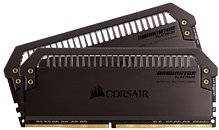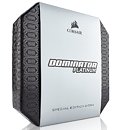Wednesday, September 28th 2016

CORSAIR Launches DOMINATOR PLATINUM Special Edition DDR4 Memory
CORSAIR, a world leader in enthusiast memory, PC components and high-performance gaming hardware today announced the immediate availability of its new DOMINATOR PLATINUM Special Edition DDR4 memory. Adding a new level of refinement and distinction to the long-standing CORSAIR DOMINATOR PLATINUM legacy, DOMINATOR PLATINUM Special Edition is available in two exclusive new styles, mirror finish Chrome and brushed aluminum Blackout. Precision crafted in strictly limited quantities of 500 kits each of 32GB (4x8GB or 2x16GB) 3,200MHz DDR4, DOMINATOR PLATINUM Special Edition also boasts improved integrated lighting via an illuminated light-pipe, patented DHX cooling technology and full XMP certification for one-touch overclocking.
Designed for world-class PC system builds where only the most elite memory will suffice, CORSAIR DOMINATOR PLATINUM Special Edition modules deliver the refinement and quality that the most discerning PC enthusiasts demand.Designed and crafted to meticulous standards, DOMINATOR PLATINUM Special Edition is CORSAIR's most elite memory ever, combining the classic and iconic DOMINATOR PLATINUM design with two new stunning finishes. DOMINATOR PLATINUM Special Edition Chrome's ultra-reflective chrome surface starts with anodized aluminum that is precision polished to a mirror finish and trimmed with sandblasted matte edging for an unprecedented display of beauty and power. In contrast, the ultra-sleek DOMINATOR PLATINUM Special Edition Blackout is engineered from black anodized aluminum, finished with polished black edging, and hand sorted to maintain a flawless finish. Each kit is individually numbered using high precision laser engraving, guaranteeing exclusivity.
Fully compatible with the latest Intel X99 and 100 series motherboards, each module is individually hand screened for added quality assurance and overclocking headroom. For discerning users looking to push their system to the limit and reach peak performance, DOMINATOR PLATINUM Special Edition's custom 10-layer PCB provides superior signaling for greater overclocking potential, allowing every DOMINATOR PLATINUM Special Edition module to be safely overclocked to at least 3,600MHz. What's more, with CORSAIR's patented DHX cooling technology, the aluminum heat-spreader is built right into the PCB, ensuring rapid heat dissipation and lower temperatures.
"DOMINATOR PLATINUM SE modules are meticulously crafted with painstaking attention to detail, manufactured in limited edition quantities of 500, and individually numbered." Said Andy Paul, CORSAIR Founder and CEO.
"These rather special and rare products will be enjoyed by an exclusive group of enthusiasts"
Dominator Platinum Special Edition Chrome and Dominator Platinum Special Edition Blackout are available immediately exclusively from the CORSAIR webstore in the United States, UK and Germany.
For more information, visit the product page.
Designed for world-class PC system builds where only the most elite memory will suffice, CORSAIR DOMINATOR PLATINUM Special Edition modules deliver the refinement and quality that the most discerning PC enthusiasts demand.Designed and crafted to meticulous standards, DOMINATOR PLATINUM Special Edition is CORSAIR's most elite memory ever, combining the classic and iconic DOMINATOR PLATINUM design with two new stunning finishes. DOMINATOR PLATINUM Special Edition Chrome's ultra-reflective chrome surface starts with anodized aluminum that is precision polished to a mirror finish and trimmed with sandblasted matte edging for an unprecedented display of beauty and power. In contrast, the ultra-sleek DOMINATOR PLATINUM Special Edition Blackout is engineered from black anodized aluminum, finished with polished black edging, and hand sorted to maintain a flawless finish. Each kit is individually numbered using high precision laser engraving, guaranteeing exclusivity.
Fully compatible with the latest Intel X99 and 100 series motherboards, each module is individually hand screened for added quality assurance and overclocking headroom. For discerning users looking to push their system to the limit and reach peak performance, DOMINATOR PLATINUM Special Edition's custom 10-layer PCB provides superior signaling for greater overclocking potential, allowing every DOMINATOR PLATINUM Special Edition module to be safely overclocked to at least 3,600MHz. What's more, with CORSAIR's patented DHX cooling technology, the aluminum heat-spreader is built right into the PCB, ensuring rapid heat dissipation and lower temperatures.
"DOMINATOR PLATINUM SE modules are meticulously crafted with painstaking attention to detail, manufactured in limited edition quantities of 500, and individually numbered." Said Andy Paul, CORSAIR Founder and CEO.
"These rather special and rare products will be enjoyed by an exclusive group of enthusiasts"
Dominator Platinum Special Edition Chrome and Dominator Platinum Special Edition Blackout are available immediately exclusively from the CORSAIR webstore in the United States, UK and Germany.
For more information, visit the product page.





21 Comments on CORSAIR Launches DOMINATOR PLATINUM Special Edition DDR4 Memory
#need :D
I know its barely adopted to begin with but, we have GDDR5 and now GDDR5x and HBM, so why are we still stuck on DDR4?
I know GDDR is a lot faster and more expensive then DDR.
And still we have HBM tech, is that somehow impossible to implement on Ram?
You can purchase a complete system with a 64-Core Intel CPU with 16GB of Embedded HBM and you can add an additional 6 DDR4 DIMMs.
dap.xeonphi.com/
It's quite hard to make high-speed interfaces and the longer the board traces, the more limited you are in terms of speed and this is why the memory modules have moved closer and closer to the CPU over the years.
For example, this is an old 386 motherboard where the memory slots were at the opposite side of the motherboard from the CPU. Back then, memory was "slow" especially compared to what we're using today and the L2 cache was also placed on the motherboard. Note that back then you needed four modules to fill a "bank" or the computer wouldn't work.
But as speeds increased, the memory slots were moved closer and closer to the CPU to avoid the use of buffering chips and complex board layouts just to keep the data intact.
The bus has also gotten a lot wider, but there's a reason why most busses in a computer are serial in nature, as it's "easy" to design them and not end up with corrupted data. However, memory is still using a parallel interface which makes it hard to design in on a motherboard.
Something like HBM uses an extremely wide bus compared to regular computer memory and this is also why it needs to be so close to the "processor" as it's simply not possible to design it in a different, cost efficient way while maintaining the data integrity.
This is also why platforms like Intel high-end stuff uses quad channel memory to try to increase the memory bus towards the processor, as it's easier the implement this on a board level.
Besides that, GDDR5 and GDDR4 are technically graphics specific versions of DDR3 with a few tweaks to allow it to operate at higher speeds. Also keep in mind that most PC's use 2x 64-bit DRAM in a dual-channel configuration, whereas only lower-end graphics cards today use a 128-bit interface, with most better cards having a 256-bit or wider bus, which results in much higher memory bandwidth. This is largely why graphics memory is so much faster than RAM, as the memory is closer to the "processor" and the bus between the GPU and the memory is much wider.
Very educational, does make me wonder though, I mean we do see memory speed going up constantly and companies bragging about benchmark results.
So would you say that if we were to put HBM memory on a memory stick and have it were the memory resides now, there would be no increase in speed?
Because I find that hard to imagine seeing as memory has not really moved on the mobo since DDR2 and we are at much faster memory now.
Or are we now hitting some limit?
Or is the added speed it would give meaningless given the speed of other parts?
Maybe this helps explains things a bit.
As you can see, the clock speed of HBM is actually really, really slow compared to GDDR5, but due to the super wide bus, you get much higher bandwidth.
Designing this into a motherboard would be nigh on impossible with today's technology, at least in a cost efficient way.
As with much technology, it's not always the best or fastest solution that becomes the commonly used thing, but the one that's the most affordable to mass produce.
TSV (Through-silicon via) is still quite complicated to manufacture and the failure rate is comparatively very high against normal DRAM and this is part of the reason why it's not widely used yet.
Technically it might be possible to mount the HBM stacks on say the rear side of the motherboard so they can interface directly with the CPU socket that way, but it doesn't seem like a sensible way of doing things and you'd still not be able to upgrade the memory.
Putting it on a DIMM of some kind simply doesn't make sense today, as how are you going to get 16 times more motherboard traces in there to handle the move from a 64-bit to a 1024-bit bus?
So the answer to your question is really quite simple, no HBM wouldn't make any sense to use as a DDR4 replacement, at least not with today's technology.
I would bought maybe one 4x8GB if someone could guarantee me compatibility with Skylake Xtreme next year.
Because I don't need more than 32GB and I like such unusual stuff and they will fit perfect in my interior. Problem is if I buy them they will work perfect on my X99 and what next year they are not compatible with Skylake Xtreme.
Even if they should work perfectly and should be in QVL if you ask me.
Skylake Xtreme arrive with DDR4 2666 and LGA 2066.
I bought small iPhone Special Edition maybe is time and for DDR4 Special Edition. :)